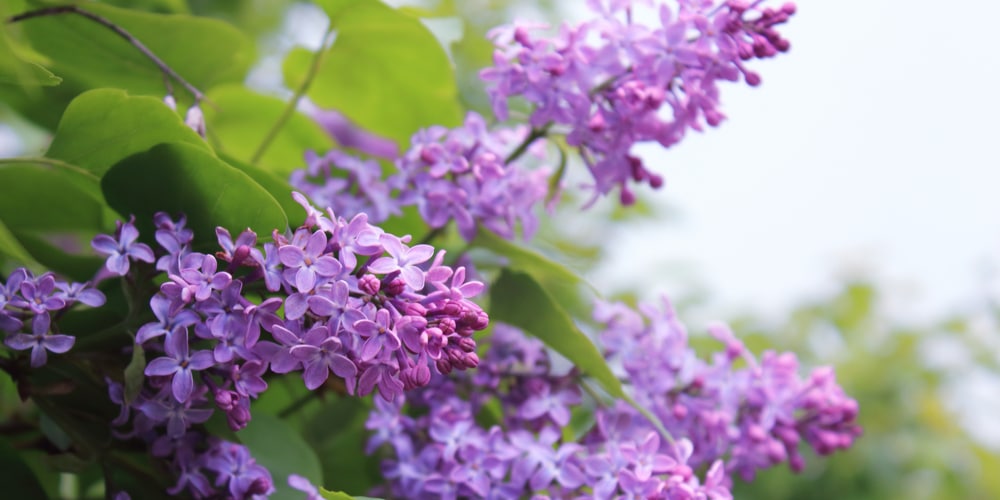Everyone loves Lilacs. These shrubs with approximately ten canes produce beautiful flowers. They are perfect if you want to enjoy sweet fragrance from your plant. Read on to learn when to plant lilacs in zone 5, among other planting guidelines for this plant.
What Are Plant Hardiness Zones?

It’s essential to explain what these zones mean before explaining how and when to plant lilacs in zone 5. A hardiness zone is a specific geographical location designated by the US Department of Agriculture. This zone contains favorable climates that encourage the growth of specific plants.
The USDA Plant Hardiness Zone Map has thirteen different zones with varying temperature degrees depending on the winter temperature they receive annually.
You should evaluate and determine the correct planting zone for your plants based on the temperature range they can withstand. Often, seed manufacturers include this information on the back of the package or labels on a new plant.
What is USDA Zone 5?
Now that we have basic knowledge of the hardiness zones let’s now understand what zone 5 comprises. It’s among the 13 USDA climate zones. It outlines areas with frost dates that receive average temperatures, such as Puerto Rico. It includes the Northeastern USA, Central US, and parts of the Northwestern US.
The climate in this zone is usually cold winters and mild summers. The minimum temperatures fall between -10 and -20 degrees Fahrenheit. The planting season is from late spring to mid-fall, with the last frost date and first frost date falling in early May and mid-October, respectively.
During winter, zone 5 gardeners should mulch their plants’ roots to protect them from freezing temperatures. Also, note that the zone has two subzones; 5a and 5b. Zone 5a experiences average minimum temperatures between -15—20 degrees F, while zone 5b has low temperatures of -10 and -15 degrees F.
When to Plant Lilacs in Zone 5
With that understanding, now we can talk about planting Lilacs in this zone. Lilacs seem to do well in USDA hardiness zones 3, 4, and 5 and some mild areas of zone 2. The best time to plant them in zone 5 is during spring when the weather is not too hot, and there’s good air circulation. But make sure you do that before the buds unfold.
Alternatively, you can plant them in the fall once the leaves have dropped. But do that before the ground starts freezing. However, note that the spring season is so short, and transplanting should only be done in areas that experience severe winters. Planting lilacs during the fall, on the other hand, gives them a better survival chance since new roots start growing out before shrubs leaf out in spring.
Lilacs are more hardy on their roots than when grated. And, they need a constant supply of sunlight for 4-6 hours daily to produce the best flowers. Gardeners should always leave 10-15 feet apart spaces between specimen displays and 5-8 feet space for a hedge effect.
How to Plant Lilacs in Zone 5?
Plant lilacs in open areas with excellent drainage. Gardeners need to offer enough room and sunlight for the plants to thrive. They mostly do well in garden settings.
Loam soil is suitable for growing lilacs as it’s not too rich. It is alkaline or neutral. But lilacs seem to do well in all soil types, provided it’s not too acidic. Add manure or a low nitrogen fertilizer with high phosphate and potash into the soil to boost its fertility. Bone Meal is recommended for lilacs as it contains lime that sweetens acidic soil to make it suitable for these plants.
To plant Lilacs:
Begin by digging a big hole that will perfectly accommodate the roots without breaking or bending them. Then add peat moss and one cup of 5-10-5 fertilizer in the hole. Doing that helps the plant produce solid roots and also fastens the plant’s growth speed.
Please make sure you mix peat moss and fertilizer with soil thoroughly. Take time to prepare the soil to help produce a strong plant with beautiful flowers.
Next, plant the lilac 2-3 inches deeper than the depth it grew in the nursery. However, the roots should be around the topsoil as setting them deeper can kill the plant. Pour water into the hole and allow it to drain. Then fill the hole using topsoil to ground level.
After, mulch with 3-4 leaves or hay to lock moisture in and prevent heaving (alternate freezing and thawing of the soil). When soil does this, it can kill the plant. Once the soil settles, ensure evenness between the area around the plant and surrounding soil. Make sure you leave 6 feet of space when planting lilacs.
Growing Lilacs in Zone 5
During spring, apply a compost layer and mulch for moisture retention and to prevent weed. Then, water during the summer if the area experiences less than one inch of rainfall every week. Again, avoid over-fertilizing lilacs as it will slow their growth or kill them. But you can fertilize during the late winter.
Once the plant blooms, spread some lime and manure on the base. Then trim to shape the bush and remove suckers as well.

